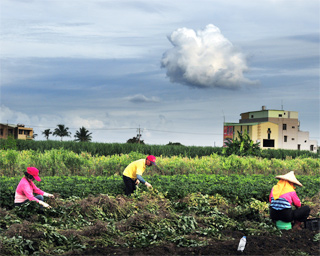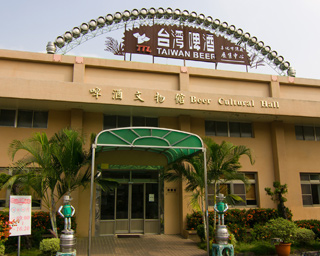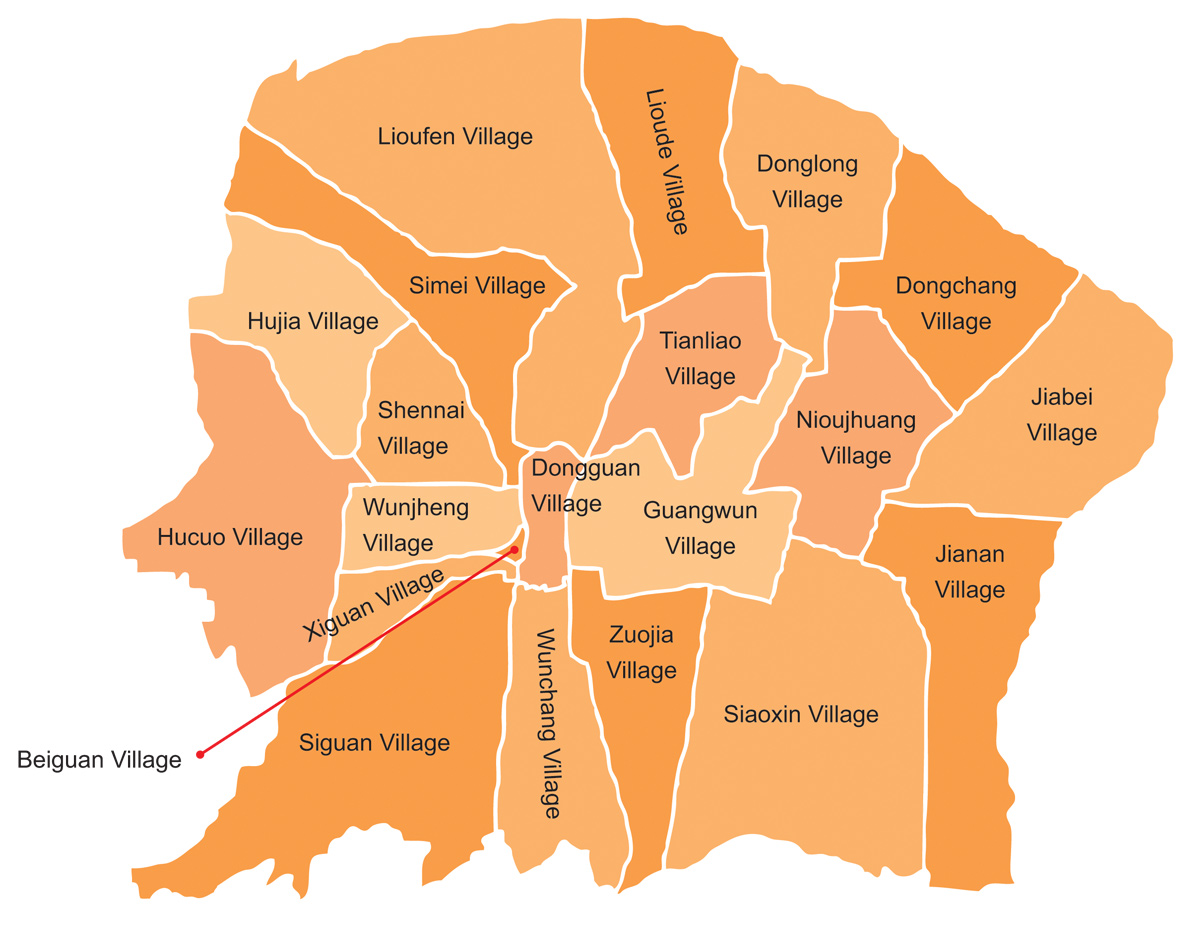 Natural environment
Natural environment
Shanhua District is the hub of the Jianan Plains and the geographical center of Tainan City. This district has green, gentle plains, fertile soil, and is populated by a rustic community who helped create productive farms. Since the ancient times, Shanhua was known as the symbol of productive Taiwanese farms and the source of power driving agricultural developments in Taiwan. With wealth comes cultural advance-ments. The Father of Taiwanese Literature, Shen Guang-wun, spent his entire life teaching students and establishing associations to further his cause of promoting litera-cy and the literary arts. The Shanhua region became known for its achievements in the field of literature and learning as well as many renowned scholars and professionals. One of them would be Chen Zih-yong, a renowned Confucian gentry and patriot who gave generous donations and led a contingent of brave militiamen to fight against the invading Japanese. Chen's courageous deeds left a positive mark and will con-tinue to influence history.
Before the 17th century, the area of Shanhua was the territory of Siraya Pingpu people living in the Backloun Settlement. The Dutch established a school in Shanhua in 1624 during the Dutch colonial era (the old Dutch well is located at the front of Cing An Temple and serves as the physical evidence of the Dutch mission.) When the Jheng Clan ruled Taiwan, Shanhua served as an important military garrison. Prince Jheng Cheng-gong (Koxsinga) named the region as Shanhua as an abbreviation for Shou-shan Jiao-hua (first region to receive enlightening education). During the Cing Administration and Japanese occupation, Shanhua remained an important hub for military mobilisation as well as land and water transport, playing important roles in the development of Tainan District.
As for the economic and development history, Zengwun River (known as Wanli River) that runs through the northern eastern side of the district provides abundant water. Settlers who arrived in this area during the Cing Administration worked hard to create productive farms. During Japanese occupation, railways and roads were constructed to facilitate transport, allowing the region to grow slowly into a prosperous commercial center. After the Second World War ended in 1945, this district focused upon agricultural facilities (with the establishment of the AVRDC - The World Vege-table Center, Shanhua Sugar Plant of Taiwan Sugar Corporation, and Shanhua Brew-ery) to help develop local industries. Since 1990, the opening of Freeway No. 3 and the establishment of the Tainan Science Park at the southwestern corner of Shanhua District also propelled further changes.
 Industry
Industry
District specialties
Shanhua District is known for its well-developed agricultural sector and its rich se-lection of agricultural produce, including sweet potatoes, tapioca, and sugarcane. Shanhua is also home to a large brewery that produces 40% of all the beer brewed by Taiwan Tobacco and Liquor Corporation. Beer is known as liquid bread. The quality of beer brewed at Shanhua is especially famous, having been awarded with the prestig-ious gold award in an international beer tasting festival. The City Government also holds regular recreational events and activities for labourers at Shanhua Brewery so that they can enjoy delicious beer.
Sweet Potato Starch
Sweet potato starch is another unique produce of Shanhua. In fact, Shanhua is known as the Kingdom of Sweet Potato Starch of Taiwan. Sweet potato starch must undergo filtration and sedimentation. It comes as no surprise that this starch also known as Dianfen (sedimented flour). Since the last years of Japanese occupation, sweet potato starch manufacturing plants have all been established at Shanhua, making the region a top producer with annual production reaching a maximum of 1500 tons. Yu Cheng Sweet Potato Starch Mill is the earliest starch mill in the area. To date, Shanhua District is home to 18 tapioca starch mills, with Yu Cheng Sweet Potato Starch Mill being the largest in terms of scale and production capacity. These starch mills produce sweet potato starch, potato starch, and tapioca starch. Sweet pota-toes or tapioca are first crushed into tiny bits using a grounder. Alum is then added to the crushed material before undergoing filtration and sedimentation. The pulp and starch slurry are then dried in the sun to create the final product.
Potato starch, sweet potato starch, and tapioca starch can be used as raw materials for beverages, food, pharmaceuticals, and chemicals. The waste pulp (liquid) can be further dried to create feed for farm animals and poultry. Wastewater is also a good source of irrigation water for its high nutrient contents. Starch mills typically start milling tapioca starch in winter and sweet potato starch in spring. In recent years, the prices of sweet potato have fallen drastically while starch sales have also slowed no-ticeably. Many growers now prefer growing more economic cash crops in order to increase their income. Sweet potatoes and tapioca used by the mills to make starch must therefore be purchased from Jiayi, Kaohsiung, and Pingdong. Increased transport costs have led to significant difficulties. Nevertheless, Shanhua has remained a leading starch producer in the area and it has played an important role in starch processing.
Folk beliefs describe sweet potato flour as a remedy against heatstroke and fevers. A concoction made by mixing freshly drawn well water with brown sugar and sweet potato flour works wonders against the heat of summer. Villagers commonly consume this beverage, which has also proven popular with many others.
There are many sweet potato cultivars. Most farmers grow Taiwan Agriculture No. 31. There is a current movement to promote Taiwan Agriculture No. 57, while No. 35-2 developed by the Asian Vegetable Research and Development Center (AVRDC) provides higher nutritional contents compared to the former cultivar. In addition to making sweet potato starch, Ganshucian (dried and preserved slices of sweet potatoes) can also be made for human consumption or as feed. In this modern day and age, how-ever, few people are eating dried sweet potato slices. However, sweet potatoes can still be prepared into popular and delicious snacks such as sweet potato porridge, roasted sweet potatoes, and sweet potato soup.
 Shanhua Brewery Shanhua Brewery of Taiwan Tobacco and Liquor Corporation (TTLC) was established at No. 2 of Cheng-gong Road. Construction began in December 1973 and the brewery was completed in December, 1975 for a total construction cost of NT$ 1.07 billion. The site occupies a total area of 14037 hectares, producing 80790 tons of malt per year and 600,000 kiloliters of beer packaged into 13 million cans. This production volume represents 38% of total beer production in the TTLC. Beer is made by brewing a mixture of malt, Penglai rice, and hops. Beer brewing starts with the processing of the raw materials followed by subsequent glycosylation, fermentation, maturation, filtration, and packaging of the completed beer. The whole process takes at least 1 month to complete. The following describes the procedure in detail:
Shanhua Brewery Shanhua Brewery of Taiwan Tobacco and Liquor Corporation (TTLC) was established at No. 2 of Cheng-gong Road. Construction began in December 1973 and the brewery was completed in December, 1975 for a total construction cost of NT$ 1.07 billion. The site occupies a total area of 14037 hectares, producing 80790 tons of malt per year and 600,000 kiloliters of beer packaged into 13 million cans. This production volume represents 38% of total beer production in the TTLC. Beer is made by brewing a mixture of malt, Penglai rice, and hops. Beer brewing starts with the processing of the raw materials followed by subsequent glycosylation, fermentation, maturation, filtration, and packaging of the completed beer. The whole process takes at least 1 month to complete. The following describes the procedure in detail:
1. Malting: Barley grain are first selected, steeped and allowed to germinate to produce the malt (germinated barley). The malt is then kilned, milled (to remove the roots) and stored. This stage takes about 2 months to complete.
2. Glycosylation: After the barley grains have sprouted, kilned, and milled, some wa-ter is then added to the mix, which is allowed to sit for some time to create the wort (liquid made from the malt.)

